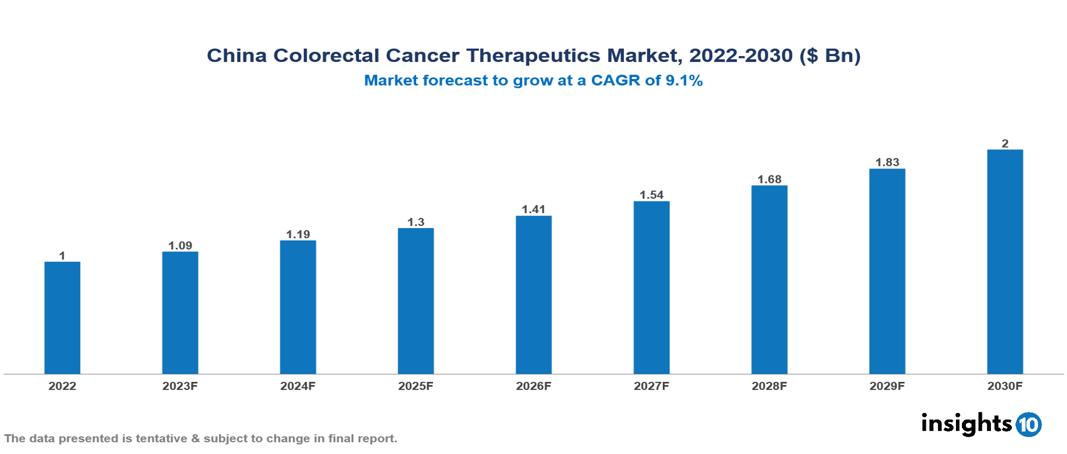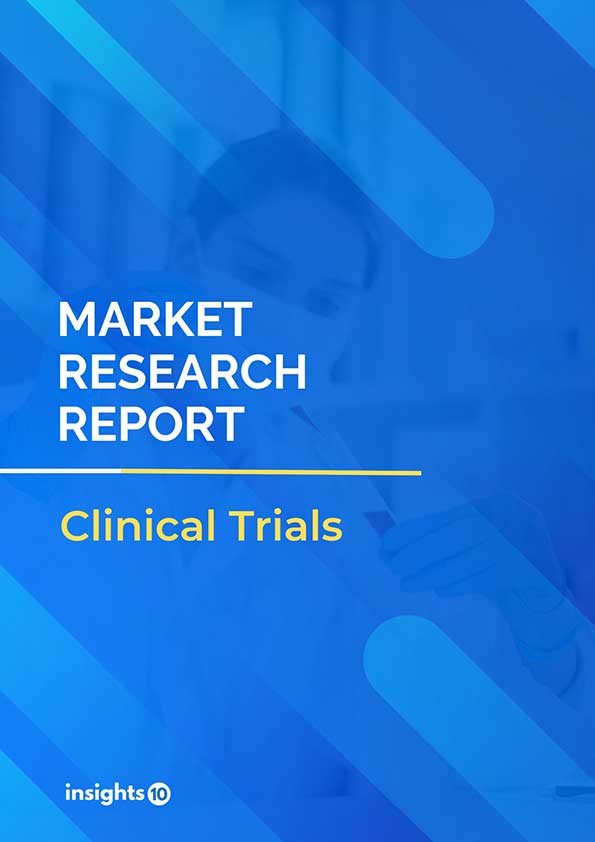China Colorectal Cancer Therapeutics Market Analysis
China Colorectal Cancer Therapeutics market is projected to grow from $xx Mn in 2023 to $xx Mn by 2030, registering a CAGR of xx% during the forecast period of 2023 ? 2030. Colon cancer, commonly known as colorectal cancer (CRC), is a condition that affects the large intestine. It is a type of cancer that develops in the colon or rectum. The surge in product introductions and colorectal cancer awareness are two factors driving the global market for drugs to treat the disease. The high incidence of colorectal cancer, which contributes to high mortality rates, and the rising global desire for more potent treatments are additional important driving forces. Genentech, Inc., Eli Lilly and Company, Pfizer Inc., Teva Pharmaceutical Industries Ltd., Bristol-Myers Squibb, Sanofi, Merck Sharp & Dohme Corp., Taiho Pharmaceutical (Otsuka Pharmaceutical Co., Ltd.), Bayer AG, Regeneron Pharmaceuticals, Inc., Novartis AG, Ipsen Biopharmaceuticals, Inc., and numerous other global companies participate in the colorectal cancer therapeutics
Buy Now


China Colorectal Cancer Therapeutics Market Analysis Summary
China Colorectal Cancer Therapeutics Market is valued at around $1 Bn in 2022 and is projected to reach $2 Bn by 2030, exhibiting a CAGR of 9.1% during the forecast period 2023-2030.
Colon cancer, commonly known as colorectal cancer (CRC), is an illness of the large intestine that develops in the colon or rectum. The worldwide prevalence of colorectal cancer, often known as colon cancer, is concerning. It is the second most prevalent cancer in women (5,71,000 cases, or 9.4% of all cancer cases), and the third most prevalent in men (6,63,000 cases, 10.0 percent of all cancer cases).
The majority of cases—nearly 60%—occur in industrialised nations. Around 6,08,000 fatalities globally are thought to be caused by CRC, which accounts for 8% of all cancer deaths and places CRC as the fourth most prevalent cancer-related cause of death. Generally speaking, CRC starts when normal colonic cells experience DNA changes (mutations). Colorectal cancer screening tests can be performed in a variety of methods. It may be possible to find anomalies in the large intestine with a physical examination. A faecal test, blood test, faecal occult blood test (FOBT), CEA test (carcinoembryonic antigen), X-ray, CT scan, colonoscopy, sigmoidoscopy, or enteroscopy are just a few of the diagnostics available. The surge in product introductions and colorectal cancer awareness are two factors driving the global market for drugs to treat the disease. The high incidence of colorectal cancer, which contributes to high mortality rates, and the rising global desire for more potent treatments are additional important driving forces. Genentech, Inc., Eli Lilly and Company, Pfizer Inc., Teva Pharmaceutical Industries Ltd., Bristol-Myers Squibb, Sanofi, Merck Sharp & Dohme Corp., Taiho Pharmaceutical (Otsuka Pharmaceutical Co., Ltd.), Bayer AG, Regeneron Pharmaceuticals, Inc., Novartis AG, Ipsen Biopharmaceuticals, Inc., and numerous other global companies participate in the colorectal cancer therapeutics
Market dynamics
Market Drivers
Increased awareness and innovation
The surge in product introductions and colorectal cancer awareness are two factors driving the global market for drugs to treat the disease. A multifaceted strategy is required for effective colorectal cancer therapy, which may result in the use of combination therapies including several drugs. A number of significant industry leaders have released a number of cutting-edge medications that address the various therapeutic requirements for colorectal cancer.
Increased incidence of disease and need for specific drugs
The high incidence of colorectal cancer, which contributes to high mortality rates, and the rising global desire for more potent treatments are additional important driving forces. Since they were first made available to the general public, drugs for colorectal cancer have experienced significant R&D advancements. Since then, a number of innovative medicines have been introduced with encouraging success rates.
Developments in the Colorectal Cancer Therapeutics market
For the treatment of solid tumours, such as breast cancer, colorectal cancer, non-small cell lung cancer, ovarian cancer, liver cancer, renal carcinomas, and head and neck squamous cell carcinoma, KRLS-004 (ASN-004) is currently being developed. The therapeutic candidate is a 5T4-oncofetal glycoprotein-targeting antibody-drug conjugate (ADC). It was created using the technique of the Dolaflexin flexible linker. The intravenous method is used for administration.
Key players
Merck & Co. Bristol Myers Squibb Eli Lilly and Company Pfizer Roche Sanofi AstraZeneca Johnson & Johnson AbbVie Celgene1. Executive Summary
1.1 Disease Overview
1.2 Global Scenario
1.3 Country Overview
1.4 Healthcare Scenario in Country
1.5 Patient Journey
1.6 Health Insurance Coverage in Country
1.7 Active Pharmaceutical Ingredient (API)
1.8 Recent Developments in the Country
2. Market Size and Forecasting
2.1 Epidemiology of Disease
2.2 Market Size (With Excel & Methodology)
2.3 Market Segmentation (Check all Segments in Segmentation Section)
3. Market Dynamics
3.1 Market Drivers
3.2 Market Restraints
4. Competitive Landscape
4.1 Major Market Share
4.2 Key Company Profile (Check all Companies in the Summary Section)
4.2.1 Company
4.2.1.1 Overview
4.2.1.2 Product Applications and Services
4.2.1.3 Recent Developments
4.2.1.4 Partnerships Ecosystem
4.2.1.5 Financials (Based on Availability)
5. Reimbursement Scenario
5.1 Reimbursement Regulation
5.2 Reimbursement Process for Diagnosis
5.3 Reimbursement Process for Treatment
6. Methodology and Scope
Market segmentations for China Colorectal Cancer Therapeutics market
By Diagnosis
- FOBT
- Fecal Calprotectin
- Narrow-Band imaging
- Endoscopic Ultrasound
- Barium enema X-ray
- Stool DNA test
- Sigmoidoscopy
- Colonoscopy
- Enteroscopy
- Virtual Colonoscopy
By Therapy
- Targeted therapy
- Immune therapy
- Chemotherapy
By Distribution Channel
- Hospitals
- Pharmacy
- Clinics
Methodology for Database Creation
Our database offers a comprehensive list of healthcare centers, meticulously curated to provide detailed information on a wide range of specialties and services. It includes top-tier hospitals, clinics, and diagnostic facilities across 30 countries and 24 specialties, ensuring users can find the healthcare services they need.
Additionally, we provide a comprehensive list of Key Opinion Leaders (KOLs) based on your requirements. Our curated list captures various crucial aspects of the KOLs, offering more than just general information. Whether you're looking to boost brand awareness, drive engagement, or launch a new product, our extensive list of KOLs ensures you have the right experts by your side. Covering 30 countries and 36 specialties, our database guarantees access to the best KOLs in the healthcare industry, supporting strategic decisions and enhancing your initiatives.
How Do We Get It?
Our database is created and maintained through a combination of secondary and primary research methodologies.
1. Secondary Research
With many years of experience in the healthcare field, we have our own rich proprietary data from various past projects. This historical data serves as the foundation for our database. Our continuous process of gathering data involves:
- Analyzing historical proprietary data collected from multiple projects.
- Regularly updating our existing data sets with new findings and trends.
- Ensuring data consistency and accuracy through rigorous validation processes.
With extensive experience in the field, we have developed a proprietary GenAI-based technology that is uniquely tailored to our organization. This advanced technology enables us to scan a wide array of relevant information sources across the internet. Our data-gathering process includes:
- Searching through academic conferences, published research, citations, and social media platforms
- Collecting and compiling diverse data to build a comprehensive and detailed database
- Continuously updating our database with new information to ensure its relevance and accuracy
2. Primary Research
To complement and validate our secondary data, we engage in primary research through local tie-ups and partnerships. This process involves:
- Collaborating with local healthcare providers, hospitals, and clinics to gather real-time data.
- Conducting surveys, interviews, and field studies to collect fresh data directly from the source.
- Continuously refreshing our database to ensure that the information remains current and reliable.
- Validating secondary data through cross-referencing with primary data to ensure accuracy and relevance.
Combining Secondary and Primary Research
By integrating both secondary and primary research methodologies, we ensure that our database is comprehensive, accurate, and up-to-date. The combined process involves:
- Merging historical data from secondary research with real-time data from primary research.
- Conducting thorough data validation and cleansing to remove inconsistencies and errors.
- Organizing data into a structured format that is easily accessible and usable for various applications.
- Continuously monitoring and updating the database to reflect the latest developments and trends in the healthcare field.
Through this meticulous process, we create a final database tailored to each region and domain within the healthcare industry. This approach ensures that our clients receive reliable and relevant data, empowering them to make informed decisions and drive innovation in their respective fields.
To request a free sample copy of this report, please complete the form below.
We value your inquiry and offer free customization with every report to fulfil your exact research needs.









































